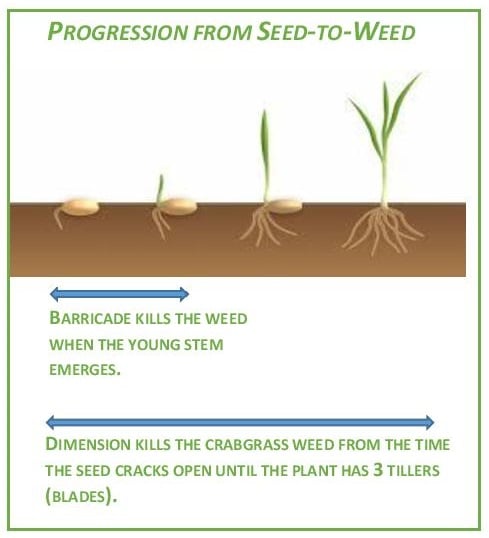Why are Two Crabgrass Treatments Needed in the Spring?
First, How is Crabgrass Prevented?
Crabgrass grows from seeds each year. Therefore, the best way to control crabgrass is to control the seeds with a “crabgrass preventer” application.
A crabgrass preventer kills the seeds when they begin to grow. We have primarily used a preventer called Barricade because it lasts longer than other products. Barricade will only kill seeds – it cannot kill crabgrass plants after they have begun growing. Barricade is supposed to give 3-4 months of control – but, there’s more to the story…
While crabgrass preventers have a residual affect for about 3-4 months after the treatment, they do break down over time. As the season goes on, and we get to the 2nd, 3rd and 4th months of the growing season, the Barricade becomes less effective.
What Does Green Giant Do to Provide Better Crabgrass Control?
 Giant’s Lawn Care programs include two crabgrass preventer treatment (at no additional charge).
Giant’s Lawn Care programs include two crabgrass preventer treatment (at no additional charge).
In the past, most lawn care programs have included just one treatment of crabgrass preventer and it was applied in our Round 1 Application in the spring – using Barricade. That will not change.
We now provide a second crabgrass treatment, which will be included in our Round 2 Application – with a product called Dimension.
While Barricade and Dimension are considered to be the best crabgrass preventers available, they do have some important differences. Barricade lasts longer into the season than Dimension, but Dimension has the added ability to kill young crabgrass plants after they sprout.
Adding the Dimension treatment has significantly reduced crabgrass problems through the summer months. This is the ‘1-2 Punch’ that crabgrass desperately needs.
Why is Crabgrass such a Big Problem in Lawns?
Crabgrass is the most common lawn weed in Pennsylvania. A mature crabgrass plant will produce approximately 10,000 seeds. These seeds get spread around by birds, wind, lawn mowers blowing them around and many other ways. The end result is that there are crabgrass seeds in soil of every lawn in southeast Pennsylvania.
To make matters more complex, crabgrass is a grass – not a nice grass like your lawn but, it is a grass – which makes it different than most lawn weeds.
For more info on What is Crabgrass is & Why is it Bad for My Lawn, click here.
What is the Guarantee?
Dealing with nature is never perfect and, it is possible, even likely, that you will still get some crabgrass in your lawn. Nevertheless, if you are on a full Green Giant lawn care program, and receive both of our crabgrass treatments, we will treat any crabgrass that grows in your lawn, at no additional charge.
If you are not on a full program, or did not receive both crabgrass treatments, for an additional charge, we can certainly treat any crabgrass that invades your lawn.
Why doesn’t Green Giant provide a guarantee if I only get one crabgrass preventer application?
Crabgrass cannot be consistently controlled with only one application, and we cannot guarantee something that we cannot control.
Background:
Over the last several years, crabgrass populations have exploded and it has caused a lot of problems on lawns. The main culprit is excessive rain & warmer weather throughout the entire growing season.
In 2017 and 2018, we had rain all through the lawn care season. In both of these years, there were no rain-free periods where the soil dried out.
In 2019, it was also very wet until late July / early August – and, by this time, the crabgrass plants were mature – the damage was already done.
These conditions enabled crabgrass seeds to germinate (sprout) all year long.
What has Changed?
In what we generally consider “normal” weather patterns, the old crabgrass prevention approach worked pretty well. But, that “normal” weather pattern would consist of the following:
- A Wet, Warm Spring
- A Dry, Hot Summer
- Mild, Wet weather from mid-September until the first hard frost (which kills crabgrass).
With this weather scenario, the crabgrass preventer primarily ‘earns its keep’ in the wet, warm spring – at the time the preventer is most effective. This is a perfect match-up – when the seeds are sprouting like crazy, the preventer is at its maximum strength – and it works like a champ!
Then, in the dry, hot summer, new crabgrass doesn’t germinate – due to lack of moisture.
Finally, when we get rain in September, crabgrass can germinate and start to grow but it will only survive for about a month before the frost kills it (also the plants are small and not much of an eyesore).
However, there are many years that do not follow this weather pattern. Instead of hot, dry periods we have ended up with very wet conditions and the crabgrass preventer just can’t keep up. These wet conditions also affects future years because the additional crabgrass plants produce more seeds that are now in the soil.
Read More about Crabgrass…